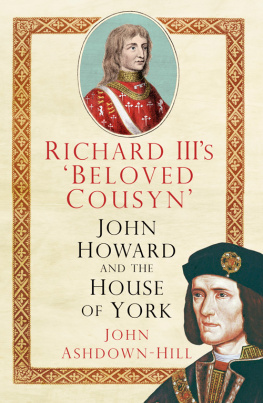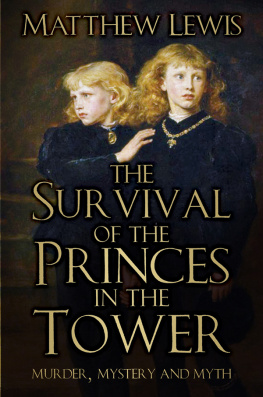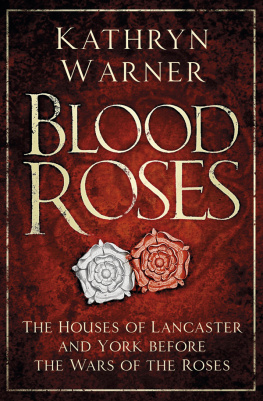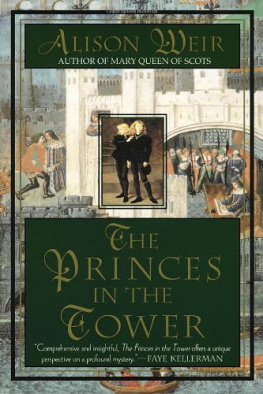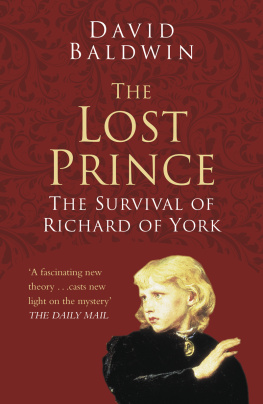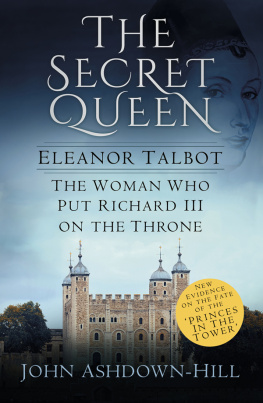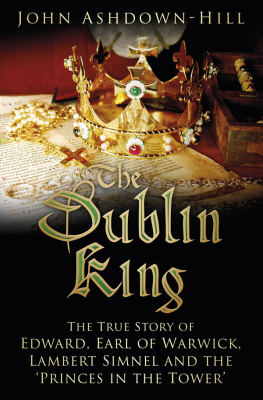
Also by GERALD PRENDERGHAST
Britain and the Wars in Vietnam:
The Supply of Troops, Arms
and Intelligence, 19451975 (McFarland, 2015)
Richard III and the Princes in the Tower
The Possible Fates of Edward V and Richard of York
GERALD PRENDERGHAST

McFarland & Company, Inc., Publishers
Jefferson, North Carolina
LIBRARY OF CONGRESS CATALOGUING DATA ARE AVAILABLE
BRITISH LIBRARY CATALOGUING DATA ARE AVAILABLE
e-ISBN: 978-1-4766-2590-4
2017 Gerald Prenderghast. All rights reserved
No part of this book may be reproduced or transmitted in any form or by any means, electronic or mechanical, including photocopying or recording, or by any information storage and retrieval system, without permission in writing from the publisher.
Cover image of Princes in the Tower 2017 duncan1890/iStock
McFarland & Company, Inc., Publishers
Box 611, Jefferson, North Carolina 28640
www.mcfarlandpub.com
Take nothing on its looks; take everything on evidence.
There is no better rule.
Mr. Jaggers, in Charles Dickens Great Expectations
Preface: Why Another Book About Richards Nephews?
From its original basis in Sir Thomas Mores account and Shakespeares subsequent historical fiction, Richards alleged murder of his nephews in the Tower during the summer or autumn of 1483 has become one of the generally accepted facts of history. This is unfortunate because the facts, such as they are, fully support neither Richards guilt nor the later theories claiming him to be an innocent victim of Tudor propaganda, although the very sparsity of the facts means that they can be presented to serve any particular turn an author chooses to take.
Books about the fate of Richards nephews are plentiful, and although many of these publications are well argued, albeit from a variety of viewpoints, they all have one unavoidable failing: the facts upon which the authors are obliged to base their speculations are too few on which to base a firm conclusion. Their texts, by virtue of the available subject matter, are forced to be mainly speculative and, unfortunately, in some of the more sensational publications, this sort of speculation has been presented as incontrovertible fact. Moreover, despite the large number of books about the boys and their uncle, the most basic questions about them still require definitive answers.
If the boys died:
Was it murder or might they have died of natural causes, such as accident or disease?
How likely would death by natural causes have been?
If it was murder, where and when was it done, and who did the actual killing?
Who might have known what happened to them?
Why is there no record of anyone coming forward after Richards death to say what happened to Edward and his little brother, when they would certainly have been well rewarded for such information?
And finally, although this is something of a side issue, why did the former friends, servants and allies of Edward IV rebel in the autumn of 1483, when they could expect no possible advantage from doing so?
Even more significantly, why did Henry Stafford, Duke of Buckingham, commit what was virtually political suicide by siding with Henry Tudor and the rebels?
If Edward and Richard did not die:
Where did they go after leaving or escaping from the Tower?
What eventually happened to them?
Clearly, it would be of little use to try to erect yet another theoretical framework based on currently available information. So this book is not of that type and consequently does not include extensive detail or discussion about the nature of Richard III or events during his reign, nor does it really set out to explain what happened to the boys, although one possible answer is suggested and discussed. Rather, its main purpose is to look at a number of different directions new research might follow and that may help to move the investigation into the boys fate forward because it is investigation and a few hard facts that are required here and not more speculation. While these events occurred over 500 years ago and many would consider a search for new material pointless, anyone who takes that view might want to consider that Mancinis manuscript, one of the main sources about the boys during the summer of 1483, was found only by the purest accident in the Lille Bibliotheque in 1934, and Richards body had to wait until 2013 before being located under a car park in Leicester.
Reference material is included here, but original sources are avoided except where they are readily available, because most of them are included in full in the standard works of reference about the period.
A final word: Fresh information does not come from a reexamination of old facts; it depends upon taking different directions. This book was written to suggest some of those directions and, as such, it is intended to serve as a point of departure for further argument and discussion, in the hope of finally providing a definitive answer to this question:
Which road did Edward and Richard take from the Tower?
Introduction
On 9 April 1483, Edward IV, king of England, died, leaving behind a twelve-year-old son, Edward V, as heir to the throne. Edward, however, was never crowned, and after being joined in the Tower by his brother Richard on 16 June 1483, neither boy was ever seen in public again. The throne was subsequently occupied by their uncle, Richard, Duke of Gloucester, who was crowned as Richard III. What really happened to his nephews has become the subject of debate, often acrimonious, since Richards death at Bosworth on that summers day in 1485.
Historians are divided into three fairly distinct factions in their opinions about Richard. There are the traditionalists, who believe everything Sir Thomas More and William Shakespeare had to say about Richard, accepting the story of the twisted, murderous hunchback who had his nephews killed to protect his own theft of the throne. Some go even further, claiming Richard intended to gain the throne even before his brothers death and that he was responsible for not only the death of Edward IV but also the deaths of both his brother, George, Duke of Clarence, and the former Lancastrian king, Henry VI.
Then there are the revisionists for whom Richard was the victim of beastly Tudor propaganda, an honorable man forced against his better nature to accept the throne to protect England from the ravages of a yet another civil war between Lancastrians and Yorkists. They further maintain that he has been unjustly blamed for the murder of the two little princes, whom he was unable to protect from his host of villainous rivals, the identity of their murderer depending upon which twist in the plot one happens to favor.
Finally, there is a group who adopt a significantly less dramatic and more balanced approach, accepting Richard as a man of his times, overly ambitious perhaps, certainly skilled in propaganda and coercion, but in truth, morally no better or worse than those who surrounded him, just more unlucky and perhaps a little too trusting.
The main feature of Richards reign, and the one that has set him apart from every other English monarch, is the controversy surrounding the fate of his nephews: the never-to-be-crowned king, Edward V, and his little brother Richard. In fact, it became much more than a simple controversy, since Richard came to be seen by many in the Tudor period, as well as by a number of later writers, as the archetypal wicked uncle, and a whole mythology subsequently grew up to justify this view, including stories about his unnatural birth, misshapen body and unnatural lusts, whose potential victims included his niece.
Next page


